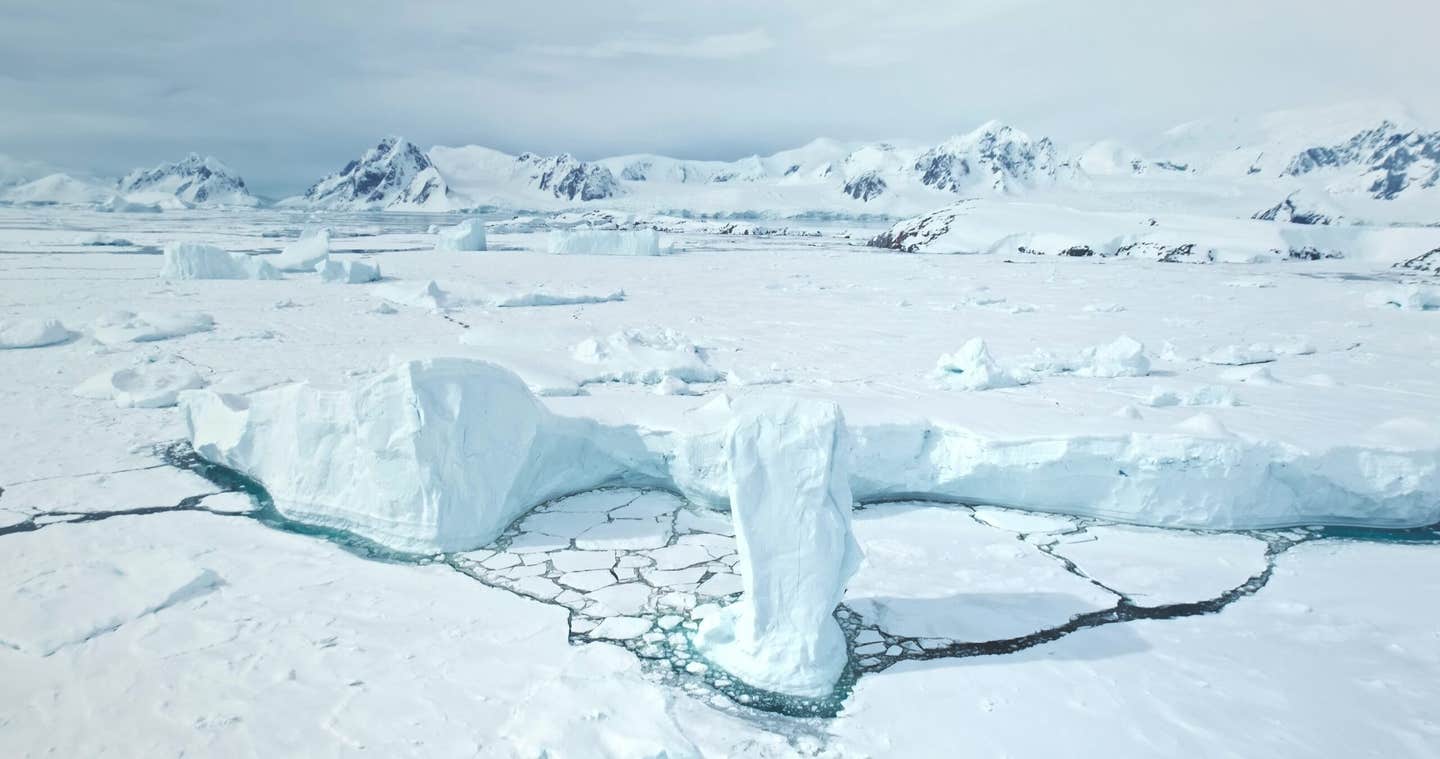Melting polar ice supercharges ocean ‘stirring’, threatening marine climate
New high resolution modeling shows polar sea ice loss will sharply intensify ocean stirring, reshaping ecosystems and climate feedbacks.

 Edited By: Joseph Shavit
Edited By: Joseph Shavit

A high resolution climate model reveals that as Arctic and Antarctic sea ice melts, horizontal stirring and turbulence in the polar oceans surge, changing how heat, nutrients, fish larvae and pollutants move through the seas and adding a new layer of risk to a warming world. (CREDIT: Shutterstock)
Polar sea ice is vanishing far faster than most people expected, and the change is not only visible from above. Beneath the thinning ice cover, the Arctic and Southern Oceans are becoming far more restless, with swirling currents that could reshape marine life and the fate of pollutants for decades to come.
An international team led by scientists at the IBS Center for Climate Physics at Pusan National University has now shown that this hidden motion will likely intensify in a warming world. Their study finds that “horizontal stirring” and turbulence in both polar oceans increase sharply as greenhouse gases rise and sea ice retreats.
What Ocean “Stirring” Really Means
In everyday life, stirring stretches a liquid into thin streaks that later mix. Something similar happens in the sea when winds and currents tug on surface waters. When this stretching and churning happens sideways over tens to hundreds of kilometers, researchers call it mesoscale horizontal stirring.
This process does more than shuffle water around. It moves heat, salt and nutrients, and helps set where plankton thrive in the upper ocean. The same motion steers fish eggs and larvae, and even guides tiny pieces of plastic or other pollutants across long distances.
For the poles, understanding this stirring is hard. The regions are remote, covered in ice for much of the year and costly to observe. Traditional climate models also struggle, because they are too coarse to capture small eddies and filaments that drive real mixing. That is where the new work stands out.
A Supercomputer View of Future Polar Seas
To peer into this fine scale world, the South Korean team used an ultra high resolution version of the Community Earth System Model, known as CESM UHR. They ran it on the Aleph supercomputer at the Institute for Basic Science in Daejeon.
The model links atmosphere, sea ice and ocean, and it does so with unusual detail. The atmosphere grid is spaced at 0.25 degrees, while the ocean grid is ten times finer, at 0.1 degrees. That tight spacing lets the model resolve eddies and fronts that older simulations blur out.
The scientists ran three long simulations. One reflects present day conditions. The second has twice today’s carbon dioxide, and the third has four times as much. For each case they analyzed ten years of daily ocean data and calculated something called finite size Lyapunov exponents.
The term sounds intimidating, but the idea is simple. It measures how quickly two nearby parcels of water drift apart under the pull of eddies and currents. Fast separation means strong stirring. Slow separation means a more sluggish ocean.
The result was clear. As the climate warmed and polar sea ice declined, horizontal stirring in the Arctic Ocean and around the Antarctic coast rose sharply. Thin, filament like structures became more common, a sign that the ocean was being stretched and twisted more intensely.
An Opening Arctic Turns Rougher
In the Arctic, the link to sea ice loss was direct. When ice disappears, winds no longer slide over a rigid lid. Instead, they can push directly on open water. That transfer of energy spins up the large scale circulation and makes it easier to generate upper ocean eddies.
With more open water, a clockwise wind pattern can strengthen the mean flow and feed energy into swirling features. Together these changes boost mesoscale horizontal stirring and turbulence across much of the basin.
“The contrast between the Arctic Ocean, which is enclosed by surrounding continents, and the Southern Ocean, where the continent is encircled by ocean, creates different physical conditions for ocean stirring. But the outcome for ocean stirring under warming is quite similar,” said lead author YI Gyuseok, a doctoral researcher at the ICCP and Pusan National University.
In the simulations, the biggest jump in stirring in the Arctic occurred between present day and the doubled carbon dioxide world, reflecting how quickly sea ice is expected to shrink as warming continues.
Around Antarctica, Fresh Water Fuels Stronger Currents
The Southern Ocean behaved differently on the surface, but the end result was the same; stronger stirring along the continent. Around Antarctica, the loss of near shore ice freshens coastal waters as more meltwater enters the sea. That fresh layer sits above saltier offshore water and sharpens the north south density contrast.
That contrast strengthens key currents such as the Antarctic Slope Current, which hugs the continent. Stronger currents feed more energy into eddies and filaments, which pushes mesoscale horizontal stirring higher along large stretches of the coast. Some regions in the model saw roughly sixty percent stronger near shore currents under severe warming compared with today.
“Horizontal stirring is a crucial factor for fish larval transport across the ocean. For moderate values, this process connects populations and habitats geographically, increasing their genetic exchange. However, for increasing stirring in the future, larvae can be transported into unsuitable areas where they may not survive,” remarks Prof. LEE June Yi from the ICCP and co corresponding author of the study.
Life, Plastics and a Less Predictable Ocean
For you, these changes may feel abstract, but for polar ecosystems they could be profound. Stronger stirring might bring up more nutrients in some places, seeding wider plankton blooms. In other places, it could sweep food away from already stressed communities.
Fish eggs and larvae that today drift between connected habitats may instead get flushed into barren or hostile waters. Microplastics and other pollutants might spread more quickly along coasts or into once sheltered bays. Even the storage of carbon in the sea could shift, as mixing reshapes where and how fast surface waters sink.
To explore those biological impacts, climate and ecosystem models will need to be woven together more tightly. “Currently, at the IBS Center for Climate Physics in South Korea, we are developing a new generation of earth system models that better integrates the interactions between climate and life. This will deepen our understanding of how polar ecosystems respond to global warming”, said Prof. Axel Timmermann, co author of the study and Director of the ICCP.
The new results send a simple message. As sea ice retreats, the polar oceans will not only grow darker and warmer. They will also grow more restless, with stronger stirring that touches everything from plankton to fisheries and pollution pathways.
Practical Implications of the Research
The study highlights a hidden risk of polar warming. Stronger horizontal stirring can alter where young fish, plankton and nutrients travel, which may disrupt existing food webs and local fisheries that rely on predictable migrations. Managers may need to adjust harvest plans and protected areas as key species shift with changing currents.
For pollution control, faster and more complex stirring means spilled oil, microplastics or other contaminants may spread farther and reach sensitive coastal zones more quickly. Planning for accidents in polar waters will need to account for this more dynamic background flow.
Climate scientists also gain a warning. Changes in mixing affect how much heat and carbon the oceans store, which feeds back on long term warming. Including realistic stirring in models will be crucial for better projections of sea level, regional climate and ice sheet stability.
Finally, the work pushes earth system modeling toward a new standard. By resolving fine scale eddies and tracking how water parcels separate, future models can link physics with biology more faithfully. That will help researchers anticipate how polar ecosystems, and the communities that depend on them, respond as the world continues to warm.
Research findings are available online in the journal Nature Climate Change.
Related Stories
- Climate change nearly wiped out early humans 900,000 years ago
- Scientists turn shrimp waste into a weapon against climate change
- Antarctica’s buried landscape may be slowing climate change, study finds
Like these kind of feel good stories? Get The Brighter Side of News' newsletter.
Mac Oliveau
Science & Technology Writer
Mac Oliveau is a Los Angeles–based science and technology journalist for The Brighter Side of News, an online publication focused on uplifting, transformative stories from around the globe. Passionate about spotlighting groundbreaking discoveries and innovations, Mac covers a broad spectrum of topics—from medical breakthroughs and artificial intelligence to green tech and archeology. With a talent for making complex science clear and compelling, they connect readers to the advancements shaping a brighter, more hopeful future.



